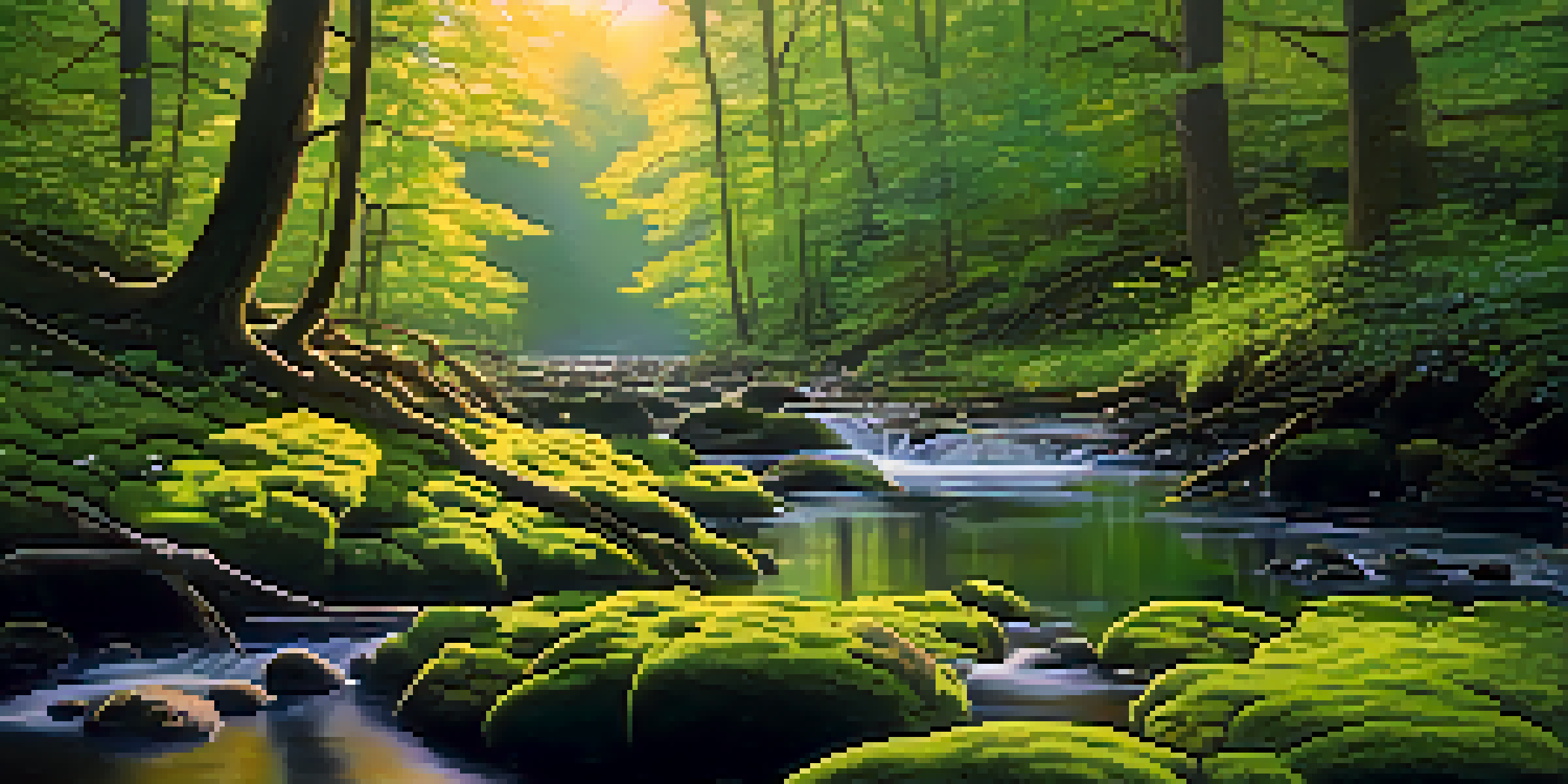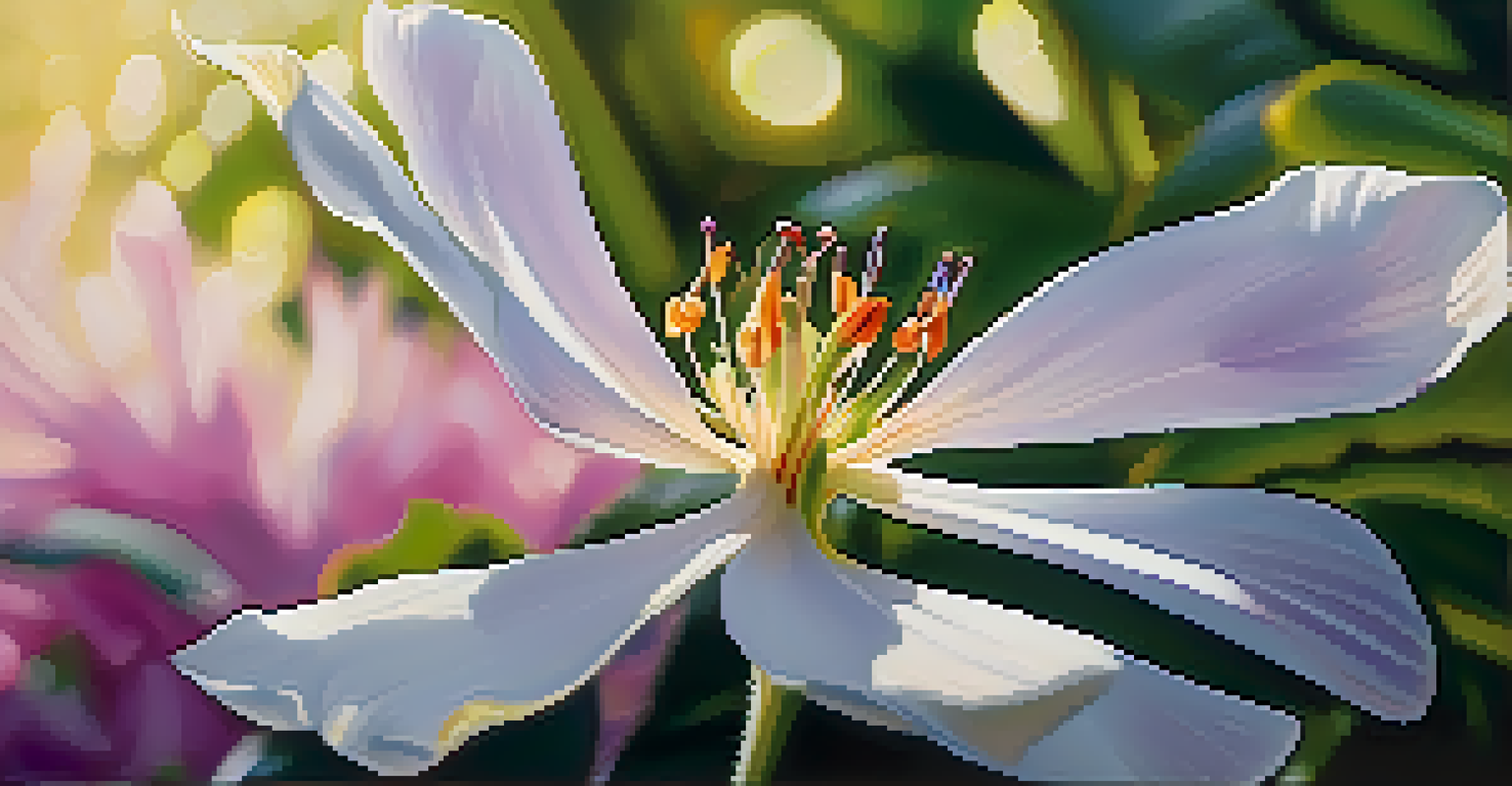Breathing in Nature: Spiritual Insights from Natural Environments

The Connection Between Nature and Spirituality
Nature has long been seen as a source of inspiration and spiritual growth. Many cultures believe that natural settings can foster a deeper connection with our inner selves. This connection often leads to a sense of peace and clarity that is hard to find in urban environments.
In every walk with nature, one receives far more than he seeks.
When we immerse ourselves in nature, we can often feel a shift in our energy and mindset. For instance, walking barefoot on grass can ground us, helping us feel more centered and connected. This interaction with our surroundings allows for personal reflection and spiritual exploration.
Moreover, natural environments have a unique way of reminding us of our place in the world. The vastness of a mountain range or the tranquility of a forest can inspire awe, prompting us to contemplate our existence and purpose. This reflective process can be spiritually enriching.
Mindfulness: Breathing with the Trees
Mindfulness in nature can enhance our spiritual experiences significantly. By focusing on our breath and the sounds around us, we can become more attuned to the present moment. Imagine standing under a canopy of trees, listening to the rustle of leaves while taking deep, intentional breaths.

Such practices can quiet our minds and allow us to connect with the essence of the natural world. When we breathe in the fresh air, we’re not just inhaling oxygen; we’re also absorbing the life force of the environment. This mindful breathing can create a profound sense of unity with nature.
Nature Enhances Spiritual Growth
Immersing ourselves in natural environments fosters reflection and a deeper connection to our inner selves.
Incorporating mindfulness into our outdoor experiences can transform simple moments into spiritual awakenings. Whether it’s observing the intricate details of a flower or the vastness of the sky, these experiences remind us of the beauty and complexity of life.
Nature as a Teacher of Patience
Nature teaches us patience in countless ways. The growth of a tree, for instance, is a slow process, reminding us that beautiful things take time to unfold. Observing this can encourage us to adopt a more patient approach to our own lives and spiritual journeys.
The clearest way into the Universe is through a forest wilderness.
As we spend time in natural settings, we can learn to appreciate the rhythms and cycles of life. The changing seasons, the blooming of flowers, and the migration of birds all demonstrate that everything has its time. This understanding can help us cultivate patience in our own personal growth.
Ultimately, nature’s lessons can guide us in developing a deeper sense of trust in the process of life. By recognizing that everything evolves at its own pace, we can ease the pressure we often put on ourselves to achieve immediate results.
The Healing Power of Natural Sounds
The sounds of nature can have a remarkable healing effect on our well-being. From the gentle rustle of leaves to the calming sound of a flowing river, these natural melodies can soothe the mind and spirit. Listening to nature can be a form of meditation that promotes relaxation and mental clarity.
Engaging with these sounds allows us to tune into a frequency that is often lost in our noisy, modern lives. When we take the time to pause and listen, we can feel a sense of connectedness that transcends our daily worries. This connection can lead to spiritual insights and personal revelations.
Mindfulness Connects Us to Nature
Practicing mindfulness in nature allows us to appreciate the present moment and enhances our spiritual experiences.
Spending time in nature while focusing on its sounds can also encourage us to be present. It can remind us to appreciate the beauty around us and inspire us to find joy in the little things, which is an essential part of our spiritual journeys.
Nature's Role in Cultivating Gratitude
Being in nature can help cultivate a deep sense of gratitude for life. When surrounded by the beauty and intricacies of the natural world, we become more aware of the gifts we often take for granted. Simple moments, like watching a sunset or feeling the breeze, can evoke feelings of appreciation.
This gratitude can extend beyond our experiences in nature, influencing our daily lives. By recognizing the beauty in our surroundings, we can develop a more positive outlook and a deeper appreciation for the simple joys of life. Gratitude has a transformative power that can enhance our spiritual well-being.
Moreover, practicing gratitude in nature can help us reconnect with our values and priorities. It reminds us of what truly matters, encouraging us to embrace a life aligned with our spiritual beliefs and values.
Finding Solitude in Natural Spaces
Nature offers a unique opportunity for solitude that many of us crave. Stepping away from the busyness of life and immersing ourselves in a quiet forest or serene beach can provide the space we need to reflect and recharge. This solitude can lead to profound spiritual insights.
In these tranquil environments, we can often hear our own thoughts more clearly. This clarity can facilitate self-discovery and inner peace, allowing us to confront our feelings and aspirations without distractions. Nature becomes a mirror, reflecting our innermost selves.
Interconnectedness Promotes Compassion
Understanding the interconnectedness of all living things encourages compassion and responsibility towards ourselves and the environment.
Ultimately, embracing solitude in nature can help us cultivate a stronger relationship with ourselves. It encourages us to listen to our intuition and connect with our true desires, paving the way for spiritual growth.
The Interconnectedness of All Living Things
One of the most profound spiritual insights we gain from nature is the interconnectedness of all living things. Observing ecosystems reveals how every creature and plant plays a vital role in maintaining balance. This awareness can deepen our appreciation for the web of life we are part of.
Understanding this interconnectedness can inspire us to act with greater compassion towards ourselves and others. Just as nature thrives on cooperation and balance, we too can find strength in community and interdependence. This realization can lead to a more holistic approach to our spiritual practices.

Moreover, recognizing our place within this web can foster a sense of responsibility towards the environment. It reminds us that our actions have consequences, both for ourselves and the world around us, encouraging us to make choices that reflect our values.